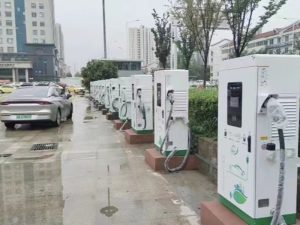As electric vehicles (EVs) gain popularity, the demand for efficient, high-speed charging solutions is surging. 480V EV chargers, high-power devices utilizing 480-volt three-phase power common in commercial and industrial settings, offer fast charging capabilities. This article delves into the definition, workings, types, benefits, applications, selection factors, and future trends of 480V EV chargers, providing a comprehensive guide to this technology.

What is a 480V EV Charger?
A 480V EV charger is a charging station that operates on 480-volt three-phase power, typically used in commercial and industrial environments to support heavy equipment and machinery. In the context of EV charging, 480V chargers enable both AC (Level 2) and DC Fast Charging (Level 3), delivering higher power outputs than standard 240V chargers. According to the Primecom 80 Amp Level 2 EV Charger, these chargers can reduce charging times significantly, up to 20 times faster than standard 110V chargers.
Types of 480V Chargers
AC Charging (Level 2)
AC chargers, typically Level 2, derive 277V single-phase voltage (line-to-neutral) from a 480V three-phase system. This setup allows for higher power outputs, such as the Primecom 80 Amp Level 2 EV Charger, which delivers up to 22kW, achieving charging speeds of approximately 80 miles per hour. However, compatibility is a key concern. According to a Reddit Discussion on 277V Charging, some Tesla models support 277V AC charging, but others, like early Ford Mustang Mach-E or Chevrolet Bolt models, may be limited to 240V. Users must verify EV compatibility with manufacturers.
|
Specification |
Details |
|---|---|
|
Voltage |
277V single-phase (derived from 480V three-phase) |
|
Power Output |
Up to 22kW |
|
Charging Speed |
Approx. 80 miles per hour |
|
Compatibility |
Supported by some Tesla models; verify for others |
|
Applications |
Workplaces, residential complexes, commercial parking |
DC Fast Charging (Level 3)
DC Fast Chargers (DCFC) convert 480V AC to DC, directly charging EV batteries. According to EVESCO DC Fast Chargers, chargers like the EVDC-120NA can deliver up to 120kW, with charging times ranging from 20 minutes to 1 hour. The 480V three-phase input is standard for DC Fast Chargers, making them suitable for high-traffic areas like highway rest stops or commercial fleet depots. Connector types (e.g., CCS or CHAdeMO) must match the target EVs.
|
Specification |
Details |
|---|---|
|
Input Voltage |
480V three-phase, 60Hz |
|
Power Output |
50kW to 350kW |
|
Charging Time |
20 minutes to 1 hour (to 80%) |
|
Connectors |
CCS, CHAdeMO, or NACS |
|
Applications |
Public charging stations, fleet operations |
Benefits of 480V EV Chargers
-
Fast Charging: DC Fast Chargers leverage high-voltage inputs to deliver high power outputs, significantly reducing charging times. For instance, the ChargePoint Express CPE 250 DC Fast Charger can provide 250 miles of range per hour.
-
Infrastructure Efficiency: In commercial or industrial sites with existing 480V power, installing 480V chargers eliminates the need for additional transformers, lowering costs.
-
High-Power Applications: Suitable for charging multiple vehicles simultaneously or large-capacity battery vehicles, such as electric buses or trucks.
-
Future-Readiness: As EV battery capacities increase, 480V chargers can meet future higher power demands.
Applications
-
Commercial Properties: Shopping centers, office buildings, and hotels can attract EV drivers by offering fast charging, increasing foot traffic.
-
Fleet Operations: Corporate EV fleets can use DC Fast Chargers to minimize downtime, enhancing operational efficiency.
-
Public Charging Stations: Highway or urban DC Fast Charging stations provide convenience for long-distance drivers.
-
Industrial Sites: Factories or warehouses can easily integrate charging stations using existing 480V infrastructure.
Choosing the Right 480V EV Charger
When selecting a 480V EV charger, consider the following factors:
|
Factor |
Considerations |
|---|---|
|
Charger Type |
AC (Level 2) for long-term parking; DC Fast for rapid charging needs. |
|
Compatibility |
AC chargers require verification of 277V support; DC chargers need compatible connectors (e.g., CCS). |
|
Power Output |
Higher outputs speed up charging but require robust electrical infrastructure. |
|
Cost |
DC Fast Chargers have higher upfront costs; AC chargers are more economical. |
|
Networking |
Features like remote monitoring, payment processing, and usage analytics enhance user experience. |
|
Installation Requirements |
Work with licensed electricians to assess power capacity and ensure compliance with local regulations. |
Technical Details
AC Charging Process
AC chargers (EVSE) deliver 277V AC to the EV, where the vehicle’s onboard charger converts it to DC to charge the battery. The J1772 standard defines AC charging connectors in North America, but voltage support varies by model. Tesla models support 277V through firmware updates, while other models may require additional verification.
DC Fast Charging Process
DC Fast Chargers have built-in converters that transform 480V AC to DC, communicating with the EV to deliver the appropriate voltage and current. The Combined Charging System (CCS) is becoming the standard for DC Fast Charging in North America, gradually phasing out CHAdeMO.
Future Trends
As the EV market grows, demand for high-power charging infrastructure will rise. Ultra-fast chargers (exceeding 350kW) may require higher input voltages, but in North America, 480V will remain a common standard for commercial applications. Integrating renewable energy sources, like solar power, with 480V charging stations will also enhance sustainability.


